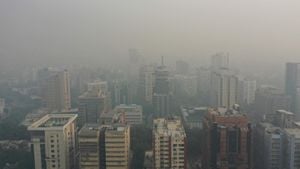Japan is bracing for the repercussions of Tropical Storm Maria, which has been unleashing intense rainfall across the northern regions, especially affecting Iwate prefecture. The powerful storm has led to significant disruptions, prompting evacuations and travel mayhem during one of Japan’s most important Buddhist holidays, Obon.
Initially classified as a typhoon, Maria has since weakened. Winds reached up to 72 kph (45 mph) when it made landfall near Ofunato City on August 12, 2024, moving northwest across the Tohoku region.
The Japan Meteorological Agency (JMA) reported heavy rainfall accumulations, with up to 46 cm (18 inches) recorded over two days, mainly impacting areas around Kuji. Prolonged heavy rain is expected, with forecasts predicting additional precipitation of 25 cm (9.8 inches) through Tuesday morning.
The Fire and Disaster Management Agency has advised about 170,000 residents across Iwate, Aomori, and Miyagi prefectures to seek shelter from the worsening conditions. Around 2,000 people had already taken refuge by the afternoon of the storm’s onslaught.
Authorities issued emergency warnings, particularly targeting cities like Kuji, where alerts raised concerns about possible flooding due to dam water releases. A significant emergency Level 5 warning was enacted, particularly for the Nagauchi and Kokuji areas.
Prime Minister Fumio Kishida has promised swift government support for those impacted by the storm's devastation. On the ground, local residents are eager for assistance as they navigate the turbulent conditions.
The prefecture has been proactive, starting emergency controlled releases of water from dams to prevent overloads, placing additional strain on riverside towns like Osanai and the city of Kuji. Muddy torrents have become commonplace, with visuals shared by local media showing rivers surging dangerously beyond their banks.
Many residents have opted for early evacuations, remembering the destructive typhoons of the past. A sobering recollection came from one Iwaizumi shelter attendee, who expressed relief at her decision to evacuate sooner this time around.
Maria’s effects on transportation have been severe; Japan Airlines and All Nippon Airways canceled flights, stranding travelers across the region. The storm’s timing amid the busy Obon holiday, where families honor their ancestors, has compounded difficulties, as train services have also faced extensive delays.
Local public transit networks, including the Akita and Tohoku Shinkansen, have halted operations, complicifying travel for thousands. The chaos illustrates how storms can disrupt not just daily life but significantly affect cultural traditions.
Historically, this storm marks only the third tropical storm to make landfall on Tohoku's Pacific coast since records began. The last noteworthy storm event, Typhoon Lionrock, took place back in 2016, bringing considerable devastation, and the memories—especially for those affected—are still fresh.
Local officials have warned citizens of the potential for mudslides and other hazardous conditions triggered by the relentless rain. A continuous watchful eye is being maintained over the water levels as the storm progresses, with flood advisories remaining active throughout affected regions.
The National Police Agency has mobilized to assist and facilitate rescue efforts throughout the affected prefectures. Local shelters are struggling to meet demand, with efforts to provide adequate resources to those displaced by the storm.
It’s not just the residents feeling the heat; towns have faced challenges from agricultural impacts as fields become swamped with excess water. Farmers are left anxiously waiting to see how the storm will affect their crops, worrying about potential long-term losses.
Even as Maria begins to fade, the alerts remain, highlighting the adversity many face as they seek to recover from the storm's effects. The combination of wind and rain poses both immediate and long-lasting problems, as waterlogged ground presents difficulties beyond just the present flooding.
Reports highlight widespread damage to infrastructure overall, with emergency services working overtime to deal with heightened demands. Footage has emerged from local areas depicting swift currents and flooded homes, painting a dire picture of the impacts felt throughout the region.
A local Iwaizumi resident’s visceral account illustrates the emotional toll: “I learned my lesson from the last typhoon and I moved fast this time!” Individuals are grappling with anxiety over their homes and communities, fearing the loss from both floods and mudslides.
The deepening disaster becomes even more concerning as forecasts predict continuous rain patterns. Each announcement carries significant worry as local governments refresh evacuation directives and flood warnings.
Maria, having transitioned from typhoon to storm, continues to showcase the volatile nature of weather patterns facing Japan amid climate change. Experts warn this scenario may become increasingly familiar if climate trends persist.
The psychological impacts are being underscored, as communities rally together to cope with uncertainty and the stress of evacuations. Families encourage one another to stay strong amid the natural chaos, recognizing resilience is key to rebuilding.
Natural disasters often serve as catalysts for communities to come together. Residents band together, sharing resources and information, maneuvering the challenges with dedication.
Meanwhile, Japan's response and recovery plans will undoubtedly be tested as efforts to stabilize and support victims get underway. Creating stronger infrastructure and preparation plans will be pivotal for future storms like Maria.
Roy Conroy, who has focused on weather patterns over the years, notes, “It’s something we will have to reckon with more often.” He calls for heightened awareness and preparedness for future weather events across Japan.
Experts point to the necessity for longer-term strategies as climate patterns evolve, reshaping global norms. It’s clear this storm has ignited dialogues about environmental practices and preparedness, especially as intense rainfall becomes alarmingly recurring.
The events of August 12, 2024, will leave lasting impressions on the lives of those affected. Maria may fade, but the memories and effects will linger for months, if not years, to come.
With the storm now passing, local resilience shines as, invariably, communities begin the long road to recovery. Awareness will be key, as everyone involved recognizes the urgency of reevaluated future approaches to handling such severe weather.
Next weeks, as Iwate and the neighboring prefectures face recovery, the necessity for investment in better infrastructure and contingency plans becomes all the more apparent. The lessons learned from Tropical Storm Maria must not only be preserved; they require immediate implementation.



